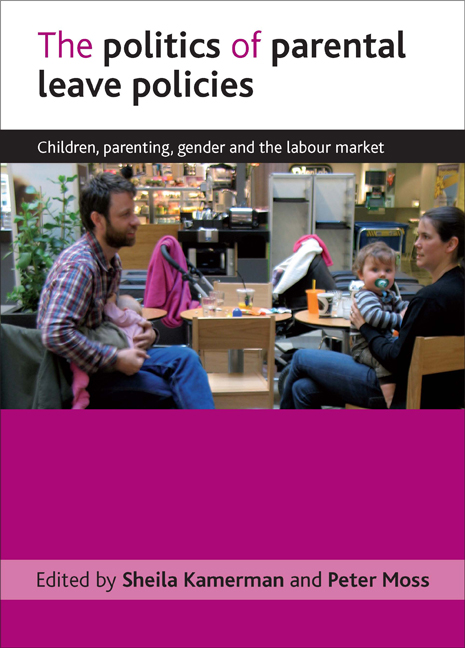Book contents
- Frontmatter
- Contents
- List of tables and figures
- Acknowledgements
- Notes on contributors
- one Introduction
- two Australia: the difficult birth of paid maternity leave
- three Canada and Québec: two policies, one country
- four Czech Republic: normative or choice-oriented system?
- five Estonia: halfway from the Soviet Union to the Nordic countries
- six Finland: negotiating tripartite compromises
- seven France: gender equality a pipe dream?
- eight Germany: taking a Nordic turn?
- nine Hungary and Slovenia: long leave or short?
- ten Iceland: from reluctance to fast-track engineering
- eleven The Netherlands: bridging labour and care
- twelve Norway: the making of the father’s quota
- thirteen Portugal and Spain: two pathways in Southern Europe
- fourteen Sweden: individualisation or free choice in parental leave?
- fifteen The European directive: making supra-national parental leave policy
- sixteen Conclusion
- Appendix
- Index
fourteen - Sweden: individualisation or free choice in parental leave?
Published online by Cambridge University Press: 05 July 2022
- Frontmatter
- Contents
- List of tables and figures
- Acknowledgements
- Notes on contributors
- one Introduction
- two Australia: the difficult birth of paid maternity leave
- three Canada and Québec: two policies, one country
- four Czech Republic: normative or choice-oriented system?
- five Estonia: halfway from the Soviet Union to the Nordic countries
- six Finland: negotiating tripartite compromises
- seven France: gender equality a pipe dream?
- eight Germany: taking a Nordic turn?
- nine Hungary and Slovenia: long leave or short?
- ten Iceland: from reluctance to fast-track engineering
- eleven The Netherlands: bridging labour and care
- twelve Norway: the making of the father’s quota
- thirteen Portugal and Spain: two pathways in Southern Europe
- fourteen Sweden: individualisation or free choice in parental leave?
- fifteen The European directive: making supra-national parental leave policy
- sixteen Conclusion
- Appendix
- Index
Summary
Maternity leave: there is no general entitlement to statutory maternity leave. But pregnant women are eligible for 50 days of leave paid at 80% of income if they work in jobs considered injurious or involving risk to the foetus.
Paternity leave: 10 working days at 80% of earnings with a ceiling of SEK410,000 per year (€36,815).
Parental leave: 480 days of leave at 80% of earnings for 390 days up to a ceiling of SEK410,000 per year (€36,815); the remaining 90 days at a flat-rate payment of SEK180 a day (€15). Sixty days are only for the mother and 60 days only for the father. The remaining 360 days are a family entitlement. In addition, each parent is entitled to take unpaid leave until a child is 18 months.
Leave to care for sick children: 120 days of leave per year per family for each child under the age of 12, and for children aged 12 to 15 with a doctor's certificate, at 80% of earnings. Sixty of these days also can be used to stay home with young children if the regular caregiver is sick.
Other: parents can take a 25% reduction of normal working hours until a child reaches the age of 8 years or completes the first grade of school; there is no payment for working reduced hours.
Sweden is a Nordic country and a member state of the European Union. It has a high level of maternal employment. It was the first country in the world to introduce parental leave, in 1974. In 2004, about 80% of fathers took paternity leave, for an average of 9.7 days out of the 10 days available. Almost all families use paid parental leave. Although mothers still take most parental leave, the proportion of total days used by men has been increasing – from 7% in 1987 to 21% in 2007. Mothers use just under two thirds of leave days taken to care for sick children (64% in 2004).
There is an entitlement to early childhood education and care for children from 12 months of age.
Introduction
The development of Swedish parental leave policy, first introduced in 1974, can be seen as an example of strategic actions from different political institutions. They starting point for this chapter is that political institutions not only act but also create cultural norms that influence public opinion (Rothstein, 2002).
- Type
- Chapter
- Information
- The Politics of Parental Leave PoliciesChildren, Parenting, Gender and the Labour Market, pp. 227 - 242Publisher: Bristol University PressPrint publication year: 2009



